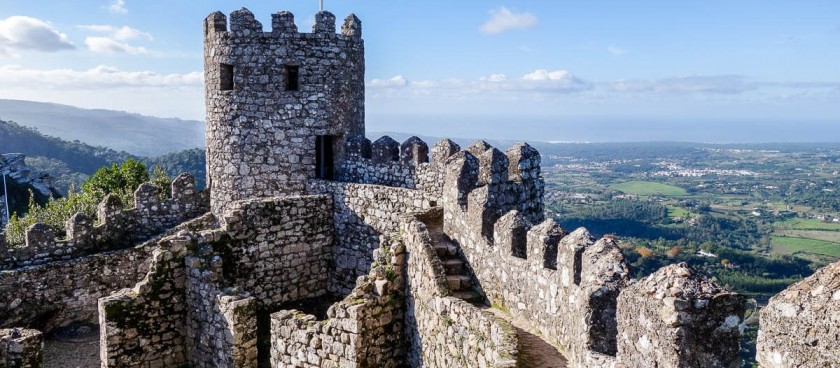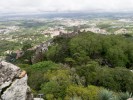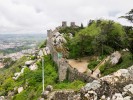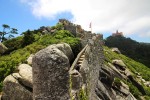- #PT27
- 2710-405 Sintra, Portugal
- +351219237300
- info@parquesdesintra.pt
- https://www.parquesdesintra.pt/en/
- Working hours*:
Every day from 10-00 to 18-00, an hour before the end of the work, the doors of the attraction are closed. Days off - December 25 and January 1. - Prices*:
adult - 8 euros;
children (from 6 to 17 years old) - 6.50 euros;
for seniors (over 65) - 6.50 euros;
family ticket (2 adults and 2 children) - 26 euros.
Admission is free for children under 6 years old. - * - opening and closing times as well as entrance prices, are subject to alterations without notice. Visitors are advised to check before visiting.
- 38.7925544, -9.3893385 Copy to clipboard Copy
-
#Castles , #Museums
The Castle of the Moors is a medieval structure built on top of a picturesque hill overlooking Sintra in Portugal. The fortress was conquered by Christians from the Moors and, during the years of reconquest (the return of the Portuguese lands), was a strategically important object. Despite the fact that today the castle looks more like a ruin, the incredible atmosphere of bygone eras, the grandeur and power of the castle has been preserved here. The Moorish castle is a UNESCO World Heritage Site.
From the height of the castle walls, a truly royal view opens up, for the sake of which many tourists visit the attraction. From here, you can see the whole city of Sintra, the vast ocean, the valleys covered with greenery and the Mafra castle.
Historical excursion
In the 8th century A.D., the territory of the modern Iberian Peninsula ruled by Muslims. To the west, they built a defensive fortress and established a small settlement. Chose the site for the construction of the structure exceptionally competently. The castle walls were an observation point from where the main routes controlled - land and sea, connecting Sintra with Lisbon, Mafra and Cascais.
Fertile land located at the foot of the hill. At the same time, the rocks surrounding the castle formed a natural defence and made the fortress practically invulnerable to the enemy. Its area was 12 thousand square meters, and the length of the walls along the perimeter was 450 meters.
In the 12th century, waged a power struggle between the Moors. The King of Portugal Afonso Henriques took advantage of, successfully conquering the palace in Lisbon, after which the Moors left Sintra.
Interesting to know!
According to one of the legends, the Moors did not expect much pressure from the crusaders and, hoping to return the land, surrendered the castle in Sintra without a fight and left treasures in the cave. Historians believe that the legend may well be a true historical fact since the Sintra hill has voids that stretch under the entire ridge and out to the sea. Most likely, the Moors used these passages to leave the castle unnoticed.
The forces of the Portuguese fortified the building, and a chapel built. On the territory of the fortress, there was always an armed detachment of soldiers of 30 people. The king awaited the return of the Moors and used the castle as an observation post. The main task of the garrison is to inform the troops in Lisbon about the approaching enemy.
In the 13th century, Sintra often visited by members of the royal family. However, the royals preferred to stay in the more luxurious national palace. The castle of the Moors was too austere and simple for them.
Gradually, the Moors' fortress falls into decay and remains abandoned for several centuries. Natural disasters accelerated the resolution - lightning struck the vault of the castle. Then in 1755, an earthquake struck, destroying the fortification.
In the 19th century, romanticism came into vogue, and then the Moors Castle's active restoration in Sintra began. The monarch of Portugal, Fernando II, began the exquisite construction of the Pena palace and park. To do this, he bought all the land in the vicinity, including the castle of the Moors, paying a little more than 200 reais for everything. The king was a romantic, which accompanied the castle's transformation: restored stone walls, planted trees, and improved paths.
Note! The castle located on a hill, so it is often windy here. Take warm clothes with you for a walk.
Castle of the Moors today
Already in the middle of the 20th century, the fortress was completely tidied up and restored. Archaeological excavations carried out on its territory, as a result of which ancient burials discovered. When the question arose about preserving the relic of national importance, the authorities developed a unique project within the reconstruction of the building. The atmosphere of the castle is truly mesmerising. It takes you into the past and makes you forget about reality.
Now on the castle territory, there is a cafe, an information centre for tourists, toilets. Paid particular attention to the safety of vacationers - pedestrian paths and stairs levelled, protective railings and curbs installed.
The Moorish castle consists of two parts:
• the castle itself;
• systems of fortifications located next to the structure.
Tourists first pass the gate. A winding path leads to the fortress, which stretches among the greenery. The ancient walls adorned with slightly frightening symbols, and nearby are the ruins of a 12th-century church.
The most picturesque and beautiful castle wall stretches from the Royal Tower. It bears a green flag with the Arabic inscription Sintra.
On all the castle towers, flags are waving, erected in a specific sequence - from the first national banner to the last one in use today.
Interesting fact! The red banner symbolised the country in the 15th century, and then the reigning monarch replaced it with a white flag. In 1834, the colours national flag colours were blue and white, after which the modern version of the banner appeared, which exists today.
Monarch Fernando II often climbed the Royal Tower. He admired the landscapes and loved to paint. In the distance, you can see the Atlantic Ocean, and on the other side - the unique architecture of the striking Pena Palace.
Near the entrance is the small chapel of San Pedro. There is an arch-shaped entrance on the wall in the southern part of the chapel, decorated with columns and decorated with floral ornaments and sculptures of fabulous animals.
There are several ways to get to the castle on your own:
Arrive by bus number 434 - the stop located next to the Sintra railway station;
by train from the capital of Portugal from the train stations Oriente, Entrecampos or Rossio, you need to go to Sintra, and then you can walk to the castle or take a taxi;
on foot - from the centre of Sintra, there are two walking routes with signs - one with a length of 1770 meters, the other - 2410 meters;
by car - from the capital of Portugal, you need to follow the IC9 road, then from the centre of Sintra follow the signs.
Useful Tips
The ascent to the castle is not the easiest one, so it is better to rent a taxi or here-truck if you not physically prepared. Sightseeing will also take strength. And don't forget about comfortable shoes.
On-site you can buy water and have a snack in the cafe.
To visit the castle, to choose a sunny day without fogs. It will be uncomfortable and dangerous to walk on wet stones, and the views are much better in clear weather.
The Castle of the Moors is undoubtedly a must-see attraction in Sintra, Portugal. The panoramic view from the walls of the building is breathtaking. The history of the castle is more than a thousand years old, and you can touch it.





